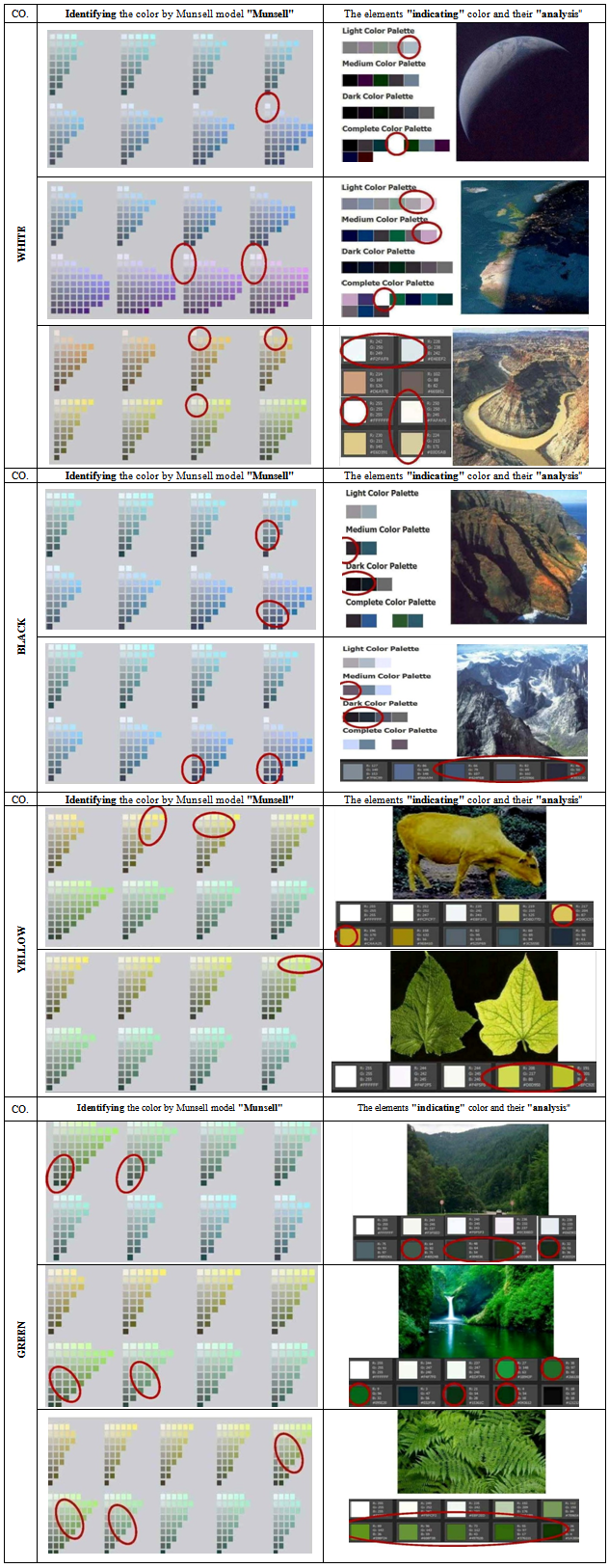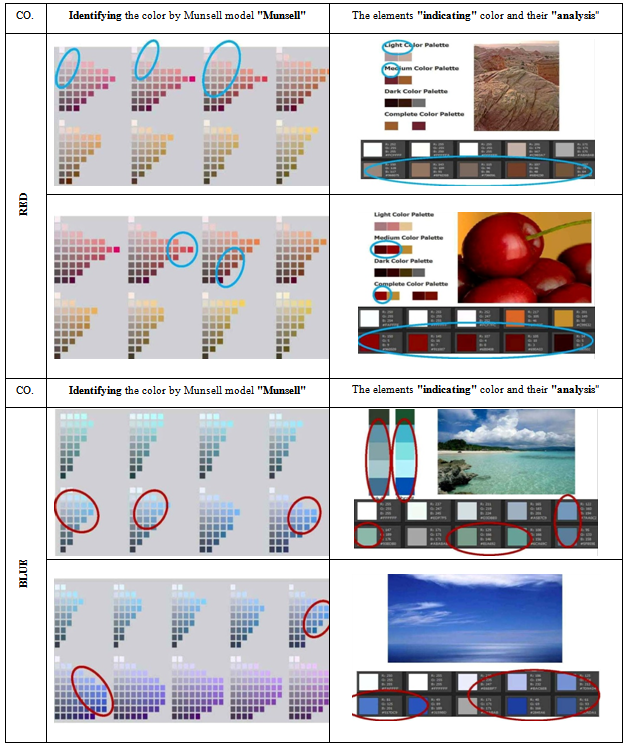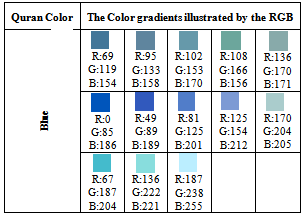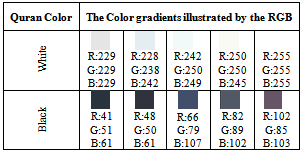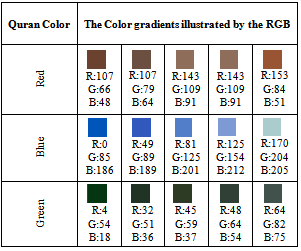-
Paper Information
- Next Paper
- Previous Paper
- Paper Submission
-
Journal Information
- About This Journal
- Editorial Board
- Current Issue
- Archive
- Author Guidelines
- Contact Us
Architecture Research
p-ISSN: 2168-507X e-ISSN: 2168-5088
2012; 2(5): 87-101
doi: 10.5923/j.arch.20120205.04
Navigation of the Holy Quran to Explore the Islamic Chromatic Patterns
Dalia Ali Taha 1, Gasser Gamil Abdel-Azim 2
1Architectural department, faculty of Engineering, Egypt, (October 6th University), P.2011, Giza
2Architectural department, faculty of Engineering, Egypt, (Misr International University-MIU), P.O.Box1, Heliopolis, Giza
Correspondence to: Dalia Ali Taha , Architectural department, faculty of Engineering, Egypt, (October 6th University), P.2011, Giza.
| Email: |  |
Copyright © 2012 Scientific & Academic Publishing. All Rights Reserved.
Formulation of a color identity to the built environment has to take into consideration group of constrains such as the broad meaning of environment, its traditions, special value, and other creative aspects. The spread of urban development within the age of globalization has caused the transition of specific colors between different places worldwide to paint buildings with similar colors though culture, civilization and environmental differences between these places. Moreover, the obvious chaotic and random use of colors in Cairo and several Arab and Islamic cities and capitals, requires solutions for such problem to help rebuilding the identity and associate sense of belonging to the community and the surrounding environment. This paper's aim is to propose a solution to this problematic issue through setting a systematic methodology to deduce and derive group of color patterns that has been mentioned in the Holy Quran. An analytical and deductive approach are used to serve the different parts of the research, in order to reach a color map that could be an aiding tool in reinforcing the identity, revitalizing, and distinguishing the urban fabric in the Islamic cities and capitals.
Keywords: Color Identity, Colors in Islamic Urbanism, Colors in the Holy Quran, Urban/Architecture in Islamic Cities
Cite this paper: Dalia Ali Taha , Gasser Gamil Abdel-Azim , "Navigation of the Holy Quran to Explore the Islamic Chromatic Patterns", Architecture Research, Vol. 2 No. 5, 2012, pp. 87-101. doi: 10.5923/j.arch.20120205.04.
Article Outline
1. Introduction
- Color is defined as the impression that light generates on the eye. The choice of color, its rejection or acceptance is taken place because of physiological, psychological, social, religious, symbolic and gustatory preferences. Each color has its psychological meaning as a result of its physiological effect on humans. Colors are joyful, relaxing, irritant, sad, distracting, worrying, painful, and disappointing. Thus, social factors such as norms, customs and traditions have its effect in the choice and preference of colors.
 | Figure 1. The use of colors in ancient ages architecture |
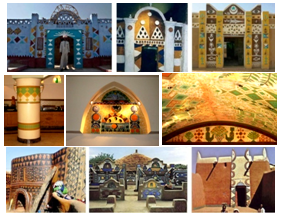 | Figure 2. Colors in local architecture – Nubba, and African villages |
 | Figure 3. Colors used in post second world war architecture (Peacock architecture) |
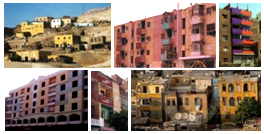 | Figure 4. The random use of color in Egypt, Arab and Islamic countries |
2. Colors in Holy Quran
- Colors in the Holy Quran is considered to be a unique phenomenon of art expression, aesthetic, and verbal expression which characterizes the Quran miraculous method. In addition to the symbolic meaning of color in Quran as an indication of the divine power, mercy, divine beauty which appears in God's various creatures, it is, as well, can be a symbol of life and death, hope and disappointment, belief and disbelief, vitality and grief, and other connotations[20]. The word (colors) and its derivatives has been mentioned in seven Holy Quran verses (interpretors see that this is an indication from God to the known seven chrome colors that formulates the white bright color), and the word (color) has been mentioned twice in one verse of the Holy Quran. These words were mentioned in the following positions:
2.1. Word Color
- They said: Call on your Lord for our sake to make it plain to us what her color is. Musa said: He says, Surely she is a yellow cow; her color is intensely yellow, giving delight to the beholders"! (Al-Baqara 69)
2.2. Word Colors
- "And the things on this earth which He has multiplied in varying colors (and qualities): verily in this a Sign for men who celebrate the praises of Allah (in gratitude)", (An-Nahl 13), "Then eat of all the fruits and walk in the ways of your lord submissively. There comes forth from within it a beverage of many colors, in which there is healing for men; most surely there is a sign in this for a people who reflect, (An-Nahl 69). "And among His Signs is the creation of the heavens and the earth, and the variations in your languages and your colors; verily in that are Signs for those who know", (Ar-Room 22). "With it We then bring out produce of various colors", (Fatir 27). "And so amongst men and crawling creatures and cattle, are they of various colors", (Fatir 28). "Seest thou not that Allah sends down rain from the sky, and leads it through springs in the earth? Then He causes to grow, therewith, produce of various colors: then it withers; thou wilt see it grow yellow; then He makes it dry up and crumble away. Truly, in this, is a Message of remembrance to men of understanding", (Az-Zumar 21). Those words were mentioned in Holy Quran to accomplish several functinos, where of its main functions are the following[18]:
2.2.1. The Expressive Function
- It appears in the direct quotations, which holds various meanings such as joy, happiness, pleasure, grief, terror, and dread.
2.2.2. The Symbolic Function
- It appears in the indirect or inspiring quotation, which calls for meditation, thinking, and reflection, as recited: "He who has made for you the fire (to burn) from the green tree, so that with it you kindle (fire)", here, the green color first symbolizes fertility, and continuity of life and then referes to the fuel for combustion and death.
2.2.3. The Sensual Function
- It depends on the effect of shapes and visuals seen in most of God's creatures on human eyes, as it is considered a mean of connection with the universe and creatures. It is an invitation for thinking and reflection, because a number of these color words were followed by the phrase " Haven't you seen that Allah…" which is a direct call to look through eyes, and think mentally, and recognize with our heart, to study these mentioned phenomenon in the Holy quran verses.
2.2.4. The Aesthetical Function
- The words (aesthetic and beautiful) are mentioned in eight Holy Quran verses, that talks about creation, moral, and sensual beauty and some of these verses were connected to colors, as recited by God: "As if they were (delicate) eggs closely guarded", (As-Saaffat 49) to indicate the beauty of paradise women described with the best women colors. The color's aesthetical function, has worked on clarifying the picture and emphasizing the idea, indulging the meaning, and affecting the person by temptation and intimidation, which awakens the heart, and is considered a source of inspiration. Modern science has defined that the primary colors of light as: red, green, and blue, while the primary colors of paint or pigments are: red, blue, and yellow. All these four colors have been mentioned in the Holy Quran (red, yellow, green, blue) considering that Allah hasn't missed anything in the Holy book[13]. Additionally, we find as well in the Holy Quran the black and white colors, because they have a special situation among colors though they are not main. Thus, it can be said that all colors have been mentioned in Holy Quran, and they are recited as following:(1) WhiteThe White color is special in its nature, function, symbolism and indication rather than other colors. However, there are various connections of this color and human behaviour. In its reality, the White color contains all the colors, thus it reflects them and the word "the white" has been mentioned once in Holy Quran in (Al Bakara) verses in God's recitation: "And eat and drink until the white thread of dawn appear to you distinct from its black thread"; ( Al-Baqara 187). The prophet's (peace be upon him) explanation about the word white is the whiteness of the day in its beginning just before sunrise[14]. Nasa space agency's cameras has recorded a picture for the area where day and night integrate, and found that it is a delicate layer with thickness no more than (1 by 100) of the earth diameter surrounded by night darkness from all sides. They installed several pictures of the Earth, and edited them with the computers. The west coast for both the european and african contenents are appeared in this processed picture and there was an obvious line separating night from day, with a clear black line in the night area, and a clear white line in the day area and a very tight area in between which is the dawn area, "Figure5".
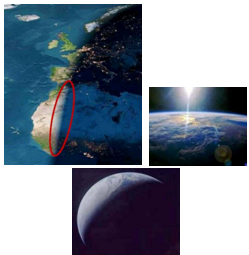 | Figure 5. The area of day and night _ photographed by NASA agency |
 | Figure 6. The layers of white and red colors appears in the mountains chain of Colorado- US and El-Petra- Jordan |
 | Figure 7. The layers of white ,black and red colors appears in the series mountains of Canada, Hawaii islands and El-Petra-Jordan |
 | Figure 8. The yellow color in various God's creatures |
 | Figure 9. Plants changing its natural color from green to yellow |
 | Figure 10. Some forests in Spain And Germany it shows the green color gradients that seems black in color |
 | Figure 11. Elements and universal creatures with the colors mentioned in Holy Quran |
 | Figure 12. Red colors and the color tone it indicates –Barcelona/ Spain |
3. Applications for the Use of Colors in Islamic Cities and Capitals
- Urban and architecure is like a painting that its aesthetical elements never be completed without the use of color. Lot of beautiful designed buildings may lost its beauty because of misuse of colors. Colors are element of attraction, where people with various cultures meet and share in feeling the aesthetical value of color and in differntiating between ugly and beautiful colors. Muslims have excelled in initiating their special achitectural trend characterizied by its unique colors concentrating on those colors mentioned in the Holy Quran. It appeared in direct application in Islamic urban and architectural environment. It has been noticed that the use of color in Arab and Islamic cities has taken different patterns, where it appeared in some cities as the monochromatic architecture (such as: Sedi Bo-Saied/Tunisia, Dara/Morocco, Jerusalem /Palestine, Amman /Jordan, Muscat/ Oman …etc.). This unity in color, in addition to the presence of greenery and trees that makes it seem as an artistic paint, might give the city an aesthetic identity, where colors were used on several levels (cities, squares, streets, public buildings and symbols, details and miniatures of Islamic buildings), "Figures 13, 14, 15, 16".
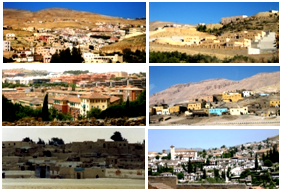 | Figure 13. On the level of islamic cities ,Towns and governorates |
 | Figure 14. On the level of Squares and public streets in some Islamic spots |
 | Figure 15. On the level of the public, symbolic, monumental , and sacred buildings |
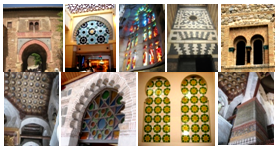 | Figure 16. On the level of the details and ornaments of the buildings |
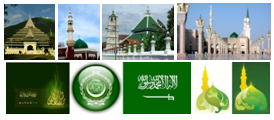 | Figure 17. The use of green color basicaly in cities logo, flags of the countries, symbols for major institutions, vital islamic websites |
4. Formulation of a Chromatic Map for the Islamic Built Environment
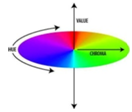 | Figure 18. The basic idea of Munsell model |
 | Figure 19. Color characteristics (The intensity, the value and the porch) |
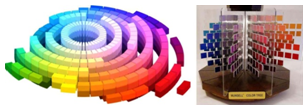 | Figure 20. 3D visualization of Munsell model |
 | Figure 21. the Congruency of the color on Munsell system |
|
|
|
|
5. Towards a Mechanism for Classifying the Color Pallets from the Holy Quran
- The color pallets that are deduced and interperted from the Holy Quran can be divided through a defined methodology to choose them through one of the consensuses and tonal variation known through using Munsell color pallet (as shown in Figure 19), which is as the following[11],[12]:
5.1. Color Harmony
- This harmony is done by two means; The first: is the monochromatic, who are dealing with colors that have common tone, but have different intensity and saturation, which might cause boredom, "Table 3". The second: is Analogous, which is usually formulated from three adjacent colors in the color pallet, such as (yellow, green, and blue), "Table 4". Thus the analogy takes place as a result of the existence of common color between the other two, which avoids monotony because of its variation.
|
5.2. Color Contrast
- It is achieved through the use of separate colors in the color pallet, to produce four different methods, combined as the following:
5.2.1. Direct Contrasted Colors
- This is resulting by choosing two opposite colors in the circle like the orange and blue, yellow and purple.
5.2.2. Analogous- Contrasted Colors
- Which is resulting from the existence of two adjacent colors in the color palette with the contrasting color to one of them, such as red, orange, and blue where red and orange are two adjacent colors and blue is the contrasted color to the orange.
5.2.3. Separate Contrasted Colors
- Which is resulting because of the existence of one color and the two colors that create its contrasting color, for example the color contrasting with red on the palette is bluish green, and thus the two separate colors are green and blue, formulated from red, blue, and green, "Table 5".
5.2.4. Double Contrasting Colors
- Which are two adjacent colors to two contrasting colors like yellow and orange with purple and blue.
|
|
|
6. Conclusions
- - It is obvious from this research paper a glimpse of the Holy Quran colors according to its diversity, origin, source, and its ability to affect the soul. It shows as well the importance of color _which is one of the elements of formation _in human life. - Holy Quran identified this importance, some of its verses came to enhance and promote the value of color and ornaments, as God recited: "And the things on this earth which He has multiplied in varying colors (and qualities): verily in this a Sign for men who celebrate the praises of Allah (in gratitude)", (An-Nahl 13).- The paper suggested a four phases methodology to formulate a chromatic map (based on the Holy Quran verses) that could be an aiding tool in reinforcing the identity, revitalizing, and distinguishing the urban fabric in the Islamic cities and capitals.- The color pallets which are deduced and interpreted from the Holy Quran could be used with its tonal variations to compose color harmony or color contrast according to the designer point of view when using colors in the built environment.- It is also suggested to classify colors in the deducted color map of Islamic built environment into three staggered levels, such as: color pallets on the level of cities, villages, and human settelments. Then the level of streets, buildings and finally the level of building details so that it would be easier for the designer to choose the suitable chromatic color in any of the three levels.This special cultural inheritance ought to be studied, by researchers and specialists to interpret realities, cultural, and historical contributions, to innovate contemporary models to be followed by Muslims in their urban and architecture in the light of Quran and the Prophetic.
 Abstract
Abstract Reference
Reference Full-Text PDF
Full-Text PDF Full-Text HTML
Full-Text HTML